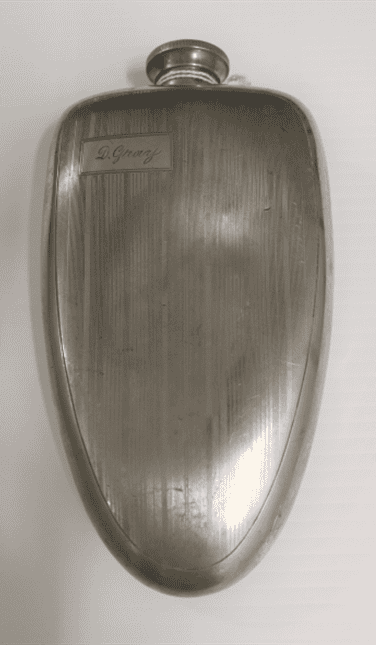Gray’s Missing Silver Flask
In 2008, the RCA Museum received a donation from Nairne Gray out of Vancouver, B.C., consisting of his father’s military memorabilia. The collection contains artifacts that belonged to Captain W. E. Duggan Gray, who landed on Juno Beach on D-Day and fought with the 3rd Anti-Tank Regiment, part of the 3rd Canadian Division. The artifacts include a silver flask with the engraving “D. Gray,” a WWII helmet, a framed medal set, discharge papers, and one newspaper article.
On 18 January 1992, the Vernon Daily News published an article written by Renee Taylor, entitled: “After 47 Years, His Flask is Back.” The published account contains unique wartime information about Captain Gray and his silver flask. In the article, Gray described himself back in 1944 as “young, stupid, and very fatalistic.” In August 1944, while fighting in France, Gray suffered a leg wound from a German mortar. British soldiers discovered Gray wounded, and transported him to hospital.

A photo of Duggan Gray holding his silver flask from 1992. Photo credit Vernon Daily News.
Due to unfortunate events and miscommunication, Gray’s unit thought he had died on the battlefield. While recovering from his wounds in hospital, his unit sent his family an erroneous telegram pronouncing his death. His family was overcome with grief. Soon after, his unit corrected the mistake, and his parents received the extraordinary news that Gray was very much alive and recovering from leg wounds sustained in action. Gray said his rebirth “created a bit of excitement. I laughed heartily about it afterwards.”
The silver flask played an integral role in the story. Before learning that Gray was still alive, the 3rd Anti-Tank Regiment sent his kit, including the engraved silver flask filled with military rum, to divisional headquarters for disposal. Once Gray was discovered alive, his unit retrieved the items. However, the rum and the silver flask had mysteriously disappeared.
Unbeknownst to Captain Gray, another Canadian soldier, James McCorriston, carried the flask for the balance of the war. Postwar, McCorriston retained the flask for decades, and in 1991, with the assistance of the War Graves Commission and the Legion Magazine, tracked down the original owner, Captain Gray. In 1992, McCorriston returned the flask to Gray during a 3rd Anti-Tank Regimental reunion dinner – 48 years after Gray had lost it in France. Gray spoke to McCorriston on how he acquired his flask, and the story goes that “some girl” gifted it to him. Gray believed McCorriston helped himself to the military rum contained in the flask, after the false reports of his death.

The silver flask in the museum’s collection 2021.
The 3rd Canadian Anti-Tank Regiment suffered heavy casualties during WW2, with one battery losing 50 percent over three days. The Canadian military mentioned Captain Gray twice in dispatches during his service in France and Belgium. Years later, after the return of the silver flask, Gray gave his military memorabilia to his son, who donated the artifacts to the RCA Museum. The silver flask has significant provenance and deserves an honourable mention. His family donated the collection to keep their father’s legacy alive, and we will honour this commitment by retelling the story of Gray’s missing silver flask.
By Andrew Oakden
